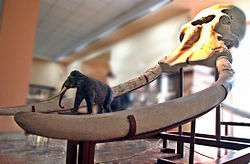Palaeoloxodon
| Palaeoloxodon Temporal range: Pleistocene | |
|---|---|
 | |
| Fossil skull of a straight-tusked elephant (P. antiquus) | |
| Scientific classification | |
| Kingdom: | Animalia |
| Phylum: | Chordata |
| Clade: | Synapsida |
| Class: | Mammalia |
| Order: | Proboscidea |
| Family: | Elephantidae |
| Subtribe: | †Palaeoloxodontina |
| Genus: | †Palaeoloxodon Matsumoto, 1924 |
| Species | |
| |
Palaeoloxodon is an extinct genus that contains the various species of straight-tusked elephant. Its species' remains have been found in Bilzingsleben, Germany; Cyprus; Japan; India; Sicily; Malta; and in England during the excavation of the second Channel Tunnel. The English discovery, in 2006 in northwest Kent, dated c. 400,000 ybp, was of a single adult; associated with it were Palaeolithic stone butchering tools of the type used by Homo heidelbergensis.[1] One species, Palaeoloxodon namadicus, was the largest known land mammal known.[2]
Taxonomy
Palaeoloxodon was originally thought to be a subgenus of Elephas, but this was abandoned by 2007.[3] It was still believed, nevertheless, to be closely related to the living Asian elephant; however, in 2016, DNA sequence analysis of P. antiquus showed that its closest extant relative is actually the African forest elephant, L. cyclotis. In fact, P. antiquus is closer to L. cyclotis than L. cyclotis is to the African bush elephant, L. africana, thus invalidating the genus Loxodonta as currently recognized.[4]
Some notable species are:
- P. antiquus (Europe, Middle east, Asia), was larger than the modern African elephant
- P. chaniensis (Crete), dwarf elephant
- P. cypriotes (Cyprus), dwarf elephant
- P. falconeri (Sicily and Malta), dwarf elephant
- P. mnaidriensis (Sicily), dwarf elephant
- P. namadicus (Asia)
- P. naumanni (Southern Japan), dwarf elephant and possible subspecies of E. namadicus
- P. recki (east Africa), the oldest (4.0 - 0.6 million years ago) and one of the largest species[5]
Extinction
The last mainland European Palaeoloxodon faced extinction 30,000 years ago. The Japanese species possibly survived for a little longer afterwards. Among the last straight-tusked elephants were the Mediterranean dwarf species, which died out 3,000 years ago - possibly at the hands of human hunters and introduced predators.
It has been claimed that a Palaeoloxodon population of undetermined species survived in northern China until 3,000 years ago. Li Ji and colleagues from the Institute of Geographic Sciences and Natural Resources Research, Beijing argued that teeth previously believed to belong to Asian Elephants were actually those of Palaeoloxodon. It is unknown whether these belong to a new, distinctive species or actual descendants of P. namadicus. They also argued that ritual bronze vessels depicting trunks with two "fingers" must be Palaeoloxodon (which are only known from bones; we do not know about their trunks) because Asian elephants only have one.[6][7] Fossil elephant experts Victoria Herridge and Adrian Lister disagree with the assignment, stating that the claimed diagnostic dental features are actually contrast artifacts created due to the low resolution of the figures in the scientific paper, and which are not evident in better quality photographs.[8] Given that we do not know what Palaeoloxodon trunks looked like, and the bronze depictions of animals shown in the paper are highly stylized, the argument based on bronze vessels is also unreliable. Thus these elephants are more likely Asian elephants, as originally believed.
References
- ↑ "Early signs of elephant butchers". BBC News. 30 June 2006.
- ↑ Larramendi, A. (2015). "Shoulder height, body mass and shape of proboscideans" (PDF). Acta Palaeontologica Polonica. 60. doi:10.4202/app.00136.2014.
- ↑ Shoshani, J.; Ferretti, M. P.; Lister, A. M.; Agenbroad, L. D.; Saegusa, H.; Mol, D.; Takahashi, K. (2007). "Relationships within the Elephantinae using hyoid characters". Quaternary International. 169-170: 174. Bibcode:2007QuInt.169..174S. doi:10.1016/j.quaint.2007.02.003.
- ↑ Callaway, E. (2016-09-16). "Elephant history rewritten by ancient genomes". Nature. doi:10.1038/nature.2016.20622.
- ↑ Turner, A. (2004) Prehistoric Mammals. Larousse
- ↑ Li, J.; Hou, Y.; Li, Y.; Zhang, J. (2012). "The latest straight-tusked elephants (Palaeoloxodon)? "Wild elephants" lived 3000 years ago in North China". Quaternary International. 281: 84. Bibcode:2012QuInt.281...84L. doi:10.1016/j.quaint.2011.10.039.
- ↑ Warwicker, Michelle (19 December 2012). "Extinct elephant 'survived late' in North China". BBC News.
- ↑ Switek, Brian. "Bronze Age Art Sparks Debate over the Straight-Tusked Elephant".